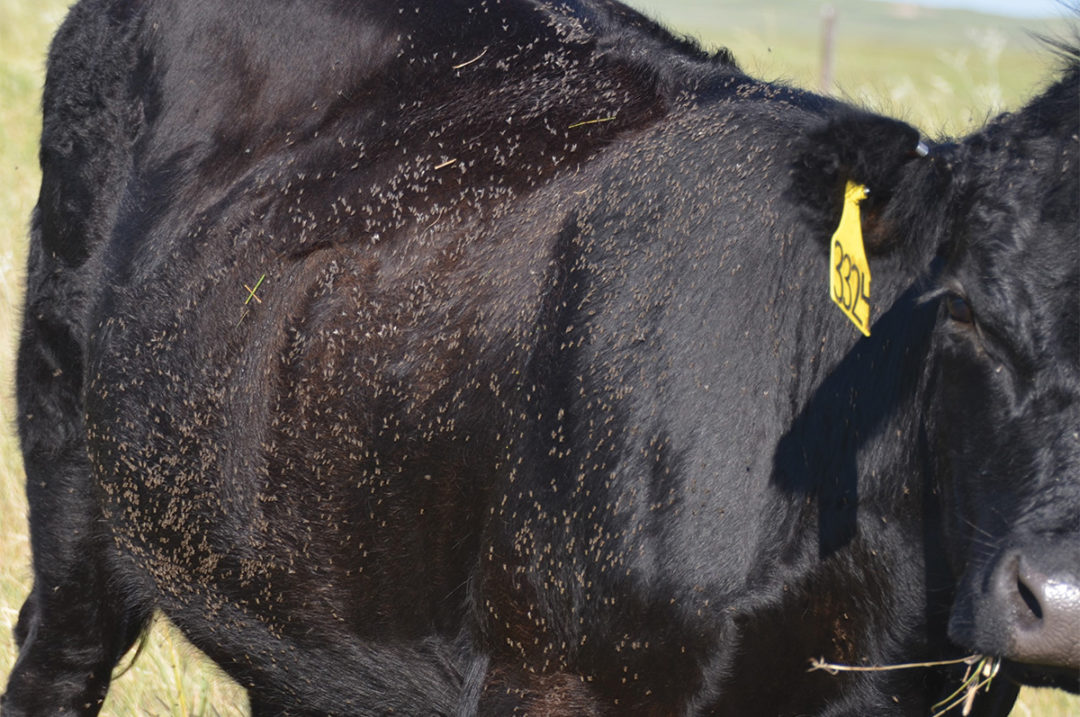The horn fly is a major pest of pasture and rangeland cattle throughout the U.S. Adult horn flies are blood-feeding flies taking, on average, 30 blood meals per day. Horn fly numbers can reach or exceed the economic injury level (EIL) very quickly. The EIL represents a fly population of 200 flies per animal that negatively impacts cattle production enough to warrant paying for a fly control measure. Once horn fly numbers surpass the EIL, cattle alter grazing patterns and behavior, reducing milk production and weight gain. In the U.S., every year cattlemen lose more than a billion dollars to horn flies.
Horn fly season for Southern states can be very long, starting in March (virtually year-round for some). States in the northern latitudes can encounter horn flies starting in April and May, with horn fly populations continuing through September and into October.
Now is the time to develop or reevaluate a horn fly management plan for 2024. If fly control in 2023 was less than desired, now is the time to alter the plan and make necessary changes. Developing a comprehensive control program can reduce the horn fly’s impact.
Selecting the most desirable control method for your operation will depend on efficacy, cost, convenience and herd management practices. Current delivery methods to control horn flies are described below. Regardless of the control method used, horn fly migration from neighboring untreated herds may mask the effectiveness of your treatment and may increase horn fly numbers above the EIL.
Dust bags
To effectively use dust bags, place the bags so that cattle must pass under them on their way to water, feed or mineral. This can be accomplished by fencing around water tanks and suspending the bags in the entrance/exit openings. Studies have shown that dust bags not placed in a forced-use arrangement provide 25% to 50% less control. One dusting location with two bags treats approximately 50 to 60 cows.
Back rubbers and oilers
As with dust bags, back rubbers and oilers are more effective when placed in a forced-use arrangement. Insecticides used with these devices should be mixed with No. 2 diesel fuel or mineral oil and should be recharged weekly. Do not 1use motor oil to dilute the insecticide as it will harm the cattle.
Pour-ons
This refers to ready-to-use insecticide products applied in measured doses along the back line of animals. They reduce flies for several weeks, so reapplication is required throughout the fly season, depending upon horn fly pressure.
Animal sprays
Insecticide sprays can be applied with low- and high-pressure sprayers or by mist blower sprayers. When using low- and high-pressure sprayers, cattle should be gathered and corralled to ensure adequate spray coverage. Mist blower applications are made in the pasture where cattle are grazing, reducing animal stress related to gathering and penning cattle. Animal sprays will provide seven to 14 days of control and will need to be reapplied throughout the fly season.
Oral larvicides
Oral larvicides, such as feed additives or insect growth regulators (IGRs), are insecticides incorporated into mineral blocks, tubs or loose mineral. These products prevent horn fly larvae developing in manure pats from becoming adults. Oral larvicides are effective when consumed in sufficient quantities throughout the fly season and should be presented to cattle 30 days prior to the start of fly season. These types of control products have no effect on adult flies.
Insecticide eartags
Eartags have one or more insecticides embedded in a plastic matrix. Movement of the head or grooming of the animal slowly releases small amounts of insecticide over time, which travels through the hair coat of the animal. Adult animals and calves should receive the number of tags recommended on the product label. Tagging only the calf and not the cow will not provide the desired level of horn fly control. At the end of the fly season, insecticide eartags should be removed to help manage fly resistance.
Compressed air application
The VetGun, a device like a paintball gun, applies an individual capsule of insecticide (VetCap) to an animal and can provide horn fly control for 10 to 35 days. VetCaps can be used on beef cattle weighing at least 600 pounds.

This is a Bruce walk-through fly trap. Photo provided by Dave Boxler.
Traps
Traps do just that – physically capture horn flies. The Bruce fly trap is a walk-through system where cattle enter through either end, pass through a 10-foot trap area and contact a series of strips made of canvas or old carpet. These strips dislodge most of the horn flies on the animals’ topline and sides. Since horn flies are attracted to light, disturbed flies move to the top of the trap where they are captured. The animal exits the trap with fewer flies on it, and the trapped flies cannot escape. Repeated use of the trap can reduce the overall local horn fly population. Like dust bags and oilers, the Bruce trap is best employed in a force-use situation where cattle must pass through it on a regular basis. For more information or how to get plans to build a Bruce fly trap, please contact me by email or phone (308) 696-6721.
Garlic
Many livestock producers have shown a strong interest in using garlic to reduce horn flies on pastured cattle. There are many forms of garlic. The most used form is garlic powder, and it is commercially available in a premixed mineral, or it can be purchased and mixed by the producer in mineral or salt, normally at a concentration of 2% garlic. It has been theorized that strong odors emitted from the skin of the animals come from organosulfur compounds metabolized after consuming garlic-based products, and these volatile metabolites of garlic are transported in the blood and emitted from the skin and thus discourage flies from taking a blood meal.
Few scientific studies have been conducted to explore the activity of garlic against the horn fly. A two-year study conducted in Canada in 2021 demonstrated in the first year that horn fly numbers were reduced by 47% on cattle offered a free choice 2% garlic-infused salt compared with an untreated group. Results from the second year demonstrated no differences in horn fly numbers between the garlic treatment and the control.
My studies using a 2% garlic powder presented in salt or mineral did not provide a significant reduction in horn fly numbers, which were well above the EIL during the fly season and very similar to fly numbers observed on the untreated (control) cattle. Additional scientific studies are needed to determine the overall impact of garlic in its different forms on horn flies.
Pasture fly resistance
Regardless of your choice of livestock fly control product and application method, plan for resistance. The recommended practice to manage resistance is to alternate insecticide mode of action (MoA) groups. Continual use of products from a single MoA group can lead to reduced control and resistance to all products in that MoA. To improve fly control and minimize resistance, do not apply insecticides within the same MoA repeatedly. Rotate between MoA groups every fly season and, if possible, during the fly season.
References omitted but are available upon request by sending an email to the editor.









